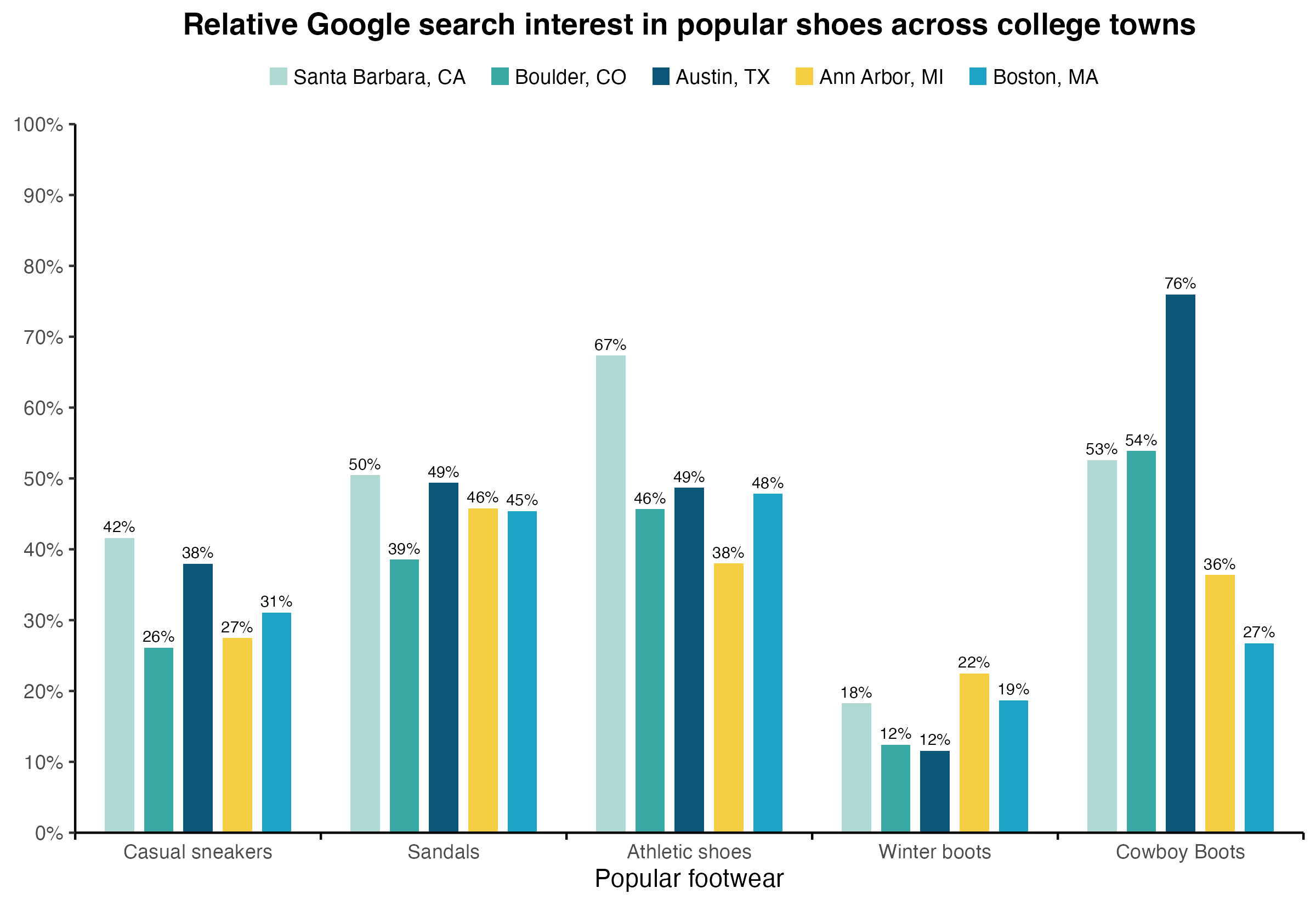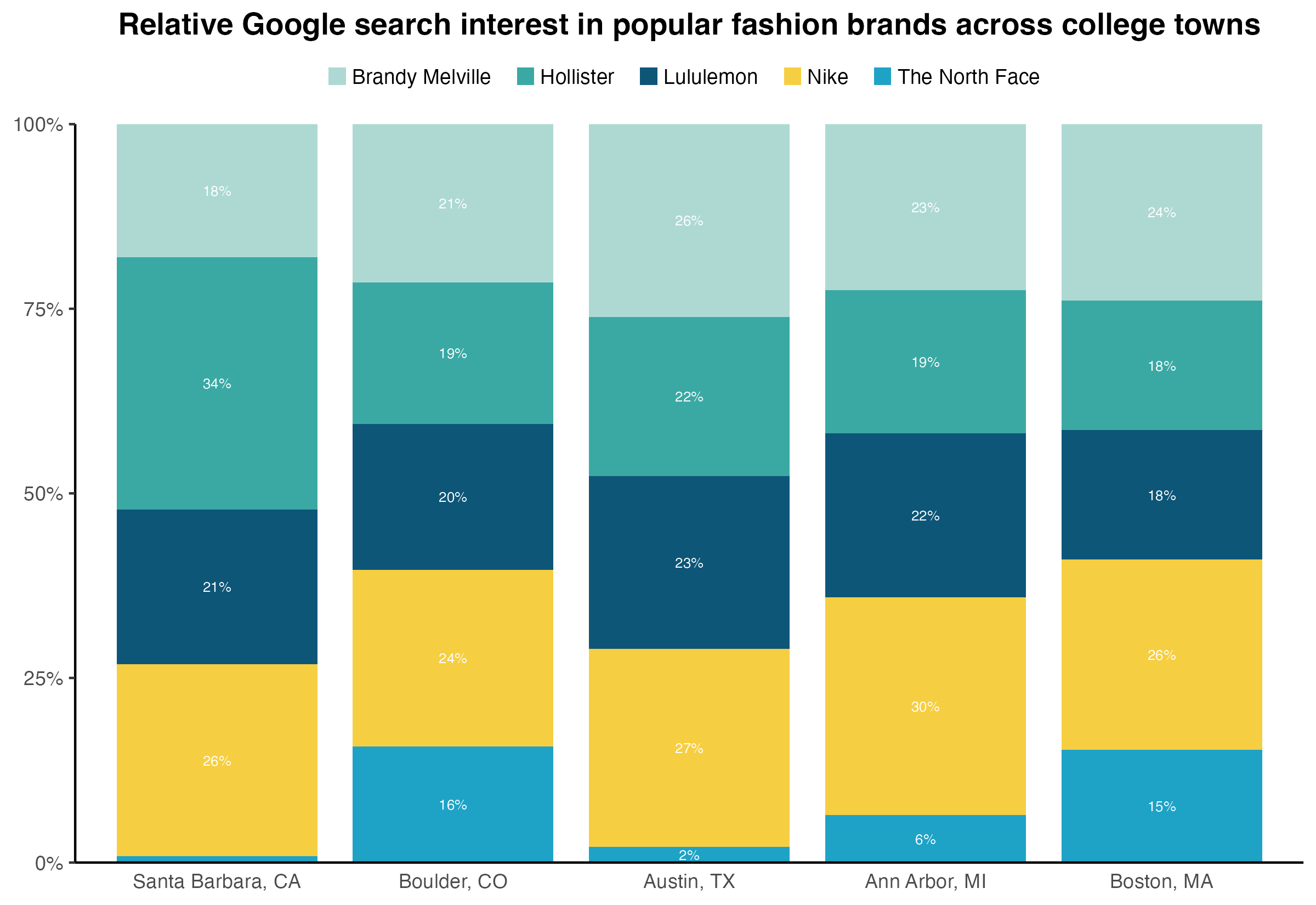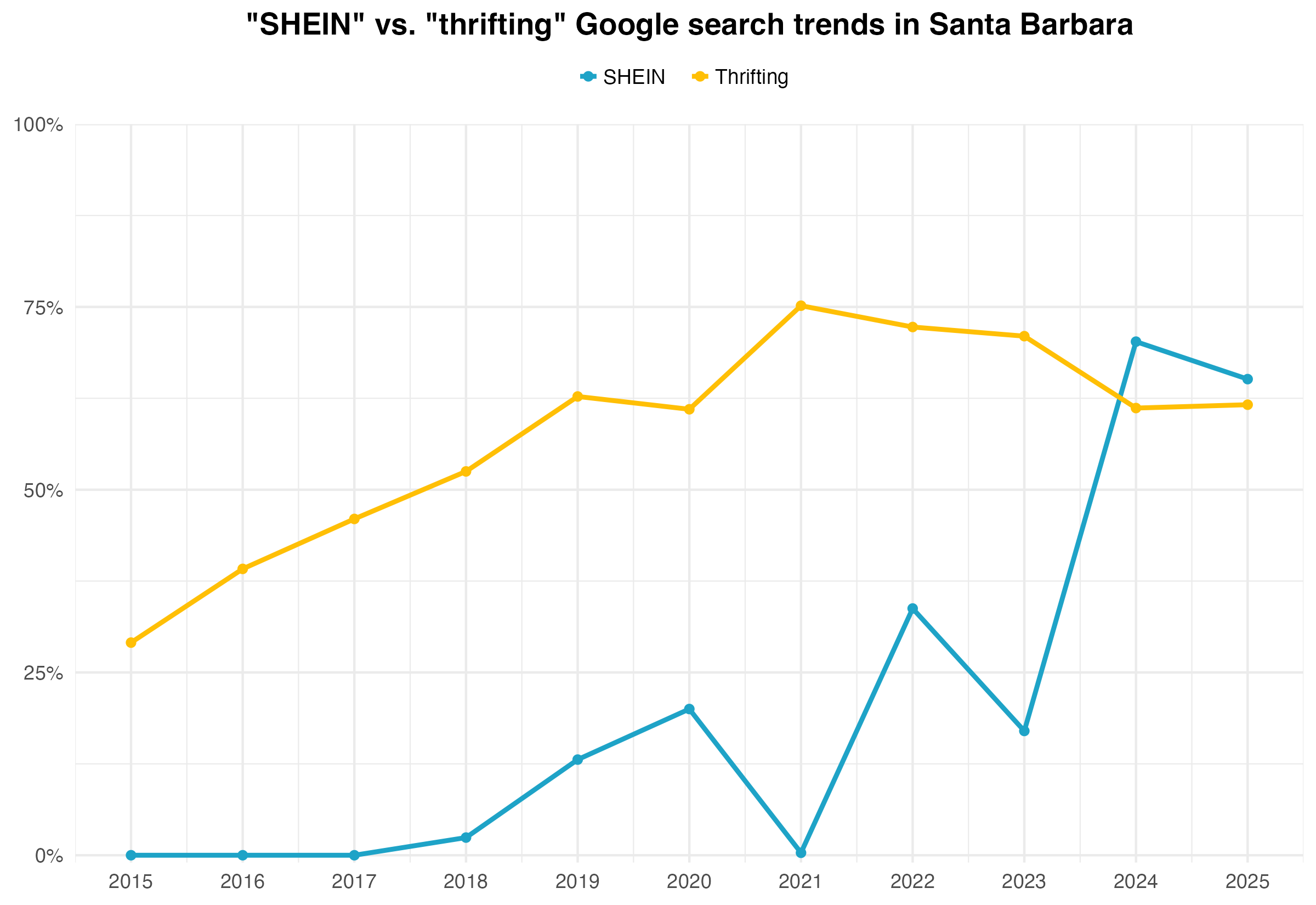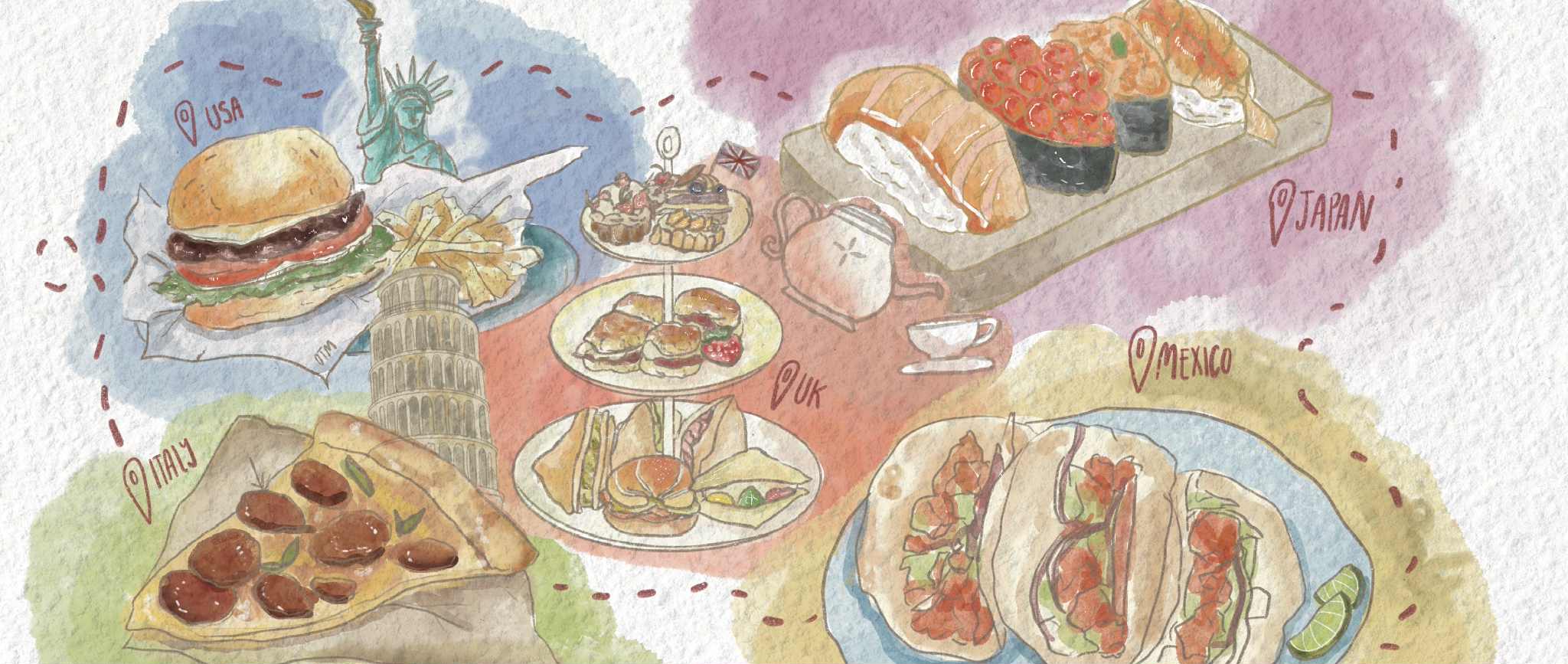With styles coming and going at lightning speed, it is easy to feel like your closet is already outdated before the quarter even begins. The race to keep up with trends can push students toward quick, low-cost fixes, but there is growing interest in making choices that are both unique and affordable.
This year, emerging styles among Gen Z have leaned toward athleisure and oversized baggy jeans, while skinny jeans have somewhat lost their appeal. Second-year biology major Maya Wu said she’s observed a growing interest in baggy streetwear styles.
“I like the more baggy clothing, like jeans and jorts. I feel many brands are starting to offer those options,” Wu said.
Wu, who works at the Hollister/Abercrombie & Fitch store at the San Francisco Premium Outlets, also observed new back-to-school trends.
“During back-to-school season, I’ve seen Hollister bringing back styles that were popular a few years ago, which are getting a lot of teenagers’ attention. The Hollister section is very busy, while Abercrombie tends to draw more adult shoppers,” Wu said.
Fourth-year communication and political science double major and president of the UCSB Fashion Club Malena Stenvall highlighted the latest trends in fashion at UCSB.
“Over the years, backpacks have been taken over by the love for huge slouchy shoulder bags that can fit everything from your laptop to your headphones to whatever snack you grabbed from The Arbor,” Stenvall said. “Obviously in SB, the go-to will always be denim and flip flops, so it’ll be fun to see how this year’s students accessorize this uniform, whether it be through chunky belts, head scarves, bangles, etc.”
Through Google Trends, the Nexus analyzed fashion trends from five towns — Santa Barbara (CA), Boulder (CO), Austin (TX), Ann Arbor (MI) and Boston (MA) — near large public universities across the United States and five major brands associated with common fashion styles trending among students today: casual, athleisure and outerwear.
Santa Barbara’s mild year-round climate allows students to embrace summery fashion choices, including footwear like flip-flops and sandals, throughout every season. In contrast to Santa Barbara, college towns in other regions of the United States like Boulder, Austin, Ann Arbor, and Boston — known for their energetic social scenes, local culture and more extreme weather — tend to favor practical and weather-resistant footwear. According to National Oceanic and Atmospheric Administration (NOAA) Online Weather Data, Boston’s temperatures in 2024 ranged from 15°F to 28°F in January and 70°F to 98°F in July, which is much more extreme than Santa Barbara’s winter lows of 52°F and summer highs of about 96°F, highlighting that local weather may shape campus style at different schools.

Relative search frequency indicates how popular a brand is compared to other searches in a region, scored on a 0-100 scale where 100 represents peak interest. This approach makes it possible to compare interests across cities of different sizes. The shoe categories shown represent common footwear types among college students, reflecting climate, lifestyle and current trends. Google Trends data current as of Aug. 17, 2025. (Grace Mundaden / Daily Nexus)
Second-year communication and sociology double major Lea Jacobson reflected on how cowboy boots became a staple in her first year at UCSB, both for school and fun.
“Cowboy boots have always been in, but I feel like they’ve definitely made a comeback in the past year for me. I love to go line dancing in SB, and people always have the cutest boots. I think they’re the perfect shoe to elevate any outfit, whether it’s for a fun night out or to wear to class!” Jacobson said.
As president of the Fashion Club, Stenvall highlighted the culture of footwear at UCSB as casual and beach friendly.
“Flip flops and Birkenstocks will always be the backbone of UCSB style, like a perfect metaphor for the campus’ carefree and easy-going nature. The charm of UCSB comes from the fact that you often have to question if a student on campus is going to class or going straight to the beach,” Stenvall said.
Stenvall added that students are mixing classic choices with newer trends.
“While traditional ballet flats or sneakers aren’t going away any time soon, this year we’re seeing a new hybrid of the two taking over footwear (think PUMA, JW PEI, etc.). Boots also had a huge moment last school year with the Frye boot craze, and I think that energy will carry over into cowboy boots or even boat boots,” Stenvall said. ”Honestly, I wouldn’t even be surprised if the ankle boot makes a comeback.”

Fashion brand popularity varies across college towns: Brandy Melville leads in Austin, Nike dominates Ann Arbor and Boston, Lululemon and Hollister are strong in Austin and Santa Barbara while The North Face remains moderately consistent. These trends highlight regional differences in student brand preferences and represent the main fashion categories trending among students today: casual, athleisure and outdoor wear. Google Trends data current as of Aug. 1, 2025. (Grace Mundaden / Daily Nexus)
Stenvall said that the fun of campus style comes from its unpredictability.
“Whether students lean toward athleisure, dressing up or somewhere in between, there is nothing more fun than watching outfits parade through The Arbor during fall quarter,” Stenvall said.
With fashion trends changing rapidly, many students may turn to fast-fashion brands like SHEIN to keep up, especially during back-to-school shopping. Second-year financial math and statistics major Deepthy Mukkara explained that the low cost is one of her primary reasons for shopping at SHEIN.
“I guess I turn to fast fashion as a backup option, especially if I’m in a rush or need something specific. It’s usually the more budget-friendly option when I’m in a pinch,” Mukkara said.
Fourth-year doctoral candidate Jaenna Wessling, who is currently researching the sustainability of apparel at the Bren School of Environmental Science & Management, explained in a statement to the Nexus how fast fashion’s rapid production and consumption have serious environmental consequences.
“From an environmental standpoint, the main concerns associated with fast fashion brands like SHEIN are high energy consumption, greenhouse gas emissions, water consumption and usage, pesticide and chemical use, microplastic pollution and waste at the end-of-life of clothing,” Wessling said. “Fast fashion is particularly harmful due to the massive amounts of apparel that are being produced annually. Since the rise of fast fashion in the late 1990s, there has been extreme growth in the amount of clothing produced and consumed annually.”
The growth of production and consumption has resulted in a rapid growth of waste and pollution. “This overproduction and overconsumption is significant for such a short time period, and is not sustainable in our current climate,” Wessling stated.
Wessling also emphasized the human cost behind fast fashion.
“The garment manufacturing industry, and especially fast fashion companies, have a record marked by poor working conditions, including low wages, forced labor, long hours, child labor, exposure to chemicals and lack of protection from unions,” Wessling said.
She added that these labor abuses have intensified due to global competition.
“Competition among developing countries to win contracts with the lowest production costs [has resulted] in widespread poverty wages (Bhattacharjee & Roy, 2016, Kates, 2019, Williams, 2022),” Wessling stated.
However, the demand for cheap, trendy clothes to keep up with the latest fashion trends may keep this harmful cycle alive, taking a toll on both people and the planet. The fashion industry produces up to 100 billion garments each year, yet as much as 92 million tons of clothing end up in landfills annually.
In response to the environmental and ethical consequences of fast fashion, thrifting has steadily gained popularity over the past decade as a sustainable alternative to fast fashion. Thrifting helps extend the life of clothes, reducing textile waste and keeping more items out of landfills. Beyond its positive environmental impact, thrifting can offer budget-friendly options for students and the chance to discover unique pieces that help them stand out.

In Santa Barbara, the relative popularity for the Google search term “thrifting” remained higher than that of the search term “SHEIN” until 2024. In 2025, “SHEIN” remains in the lead. Google Trends data current as of Aug. 20, 2025. (Grace Mundaden / Daily Nexus)
Thrifting has become a go-to option for many UCSB students, with local shops and community events making it easy to participate. Escobar’s Little Things, located in the heart of Isla Vista, offers a variety of garments from cowboy boots to formal dresses. Just a short bus ride away are other options like Alpha Thrift Store, Crossroads Trading and Urban Flea Market.
Stenvall added that one of her favorite thrift pieces is her Kate Spade bag.
“My personal Kate Spade brown school bag that I have used every day since buying it from Alpha Thrift my sophomore year,” Stenvall said.
Second-year psychological & brain sciences major Cody Lee said a knitted vest he thrifted is one of his favorite pieces.
“Knitted vests have always been an appeal for me since my dad always wore them. I was in SF with my friend and just found it at a thrift store. Now I wear it all the time,” Lee said.
Furthermore, Santa Barbara resident Brittney Cotledge holds Thriftopia at least once a quarter at Little Acorn Park to make thrifting more accessible for students to find unique pieces and keep fashion fun without sacrificing the planet. The first Thriftopia of the school year will take place on Saturday, September 27.
“Buying less is the most sustainable choice we can make. We vote with our dollars, so in collectively decreasing our consumption, we can decrease demand and overproduction,” Wessling said.
A version of this article appeared on p. 22 and p. 23 of the August 28, 2025 edition of the Daily Nexus.




















